Visits: 31
Fashion brands have been told they must do more than just make “commitments” to ethical practices, with experts saying that unless words are followed by actions it amounts to very little.
A report from Oxfam and Monash University released last month urged brands to commit to purchasing practices that reduce human rights risks in their supply chains, and to work towards ensuring safety and living wages for garment workers.
But Dr Harriette Richards, an honorary fellow of cultural studies at the University of Melbourne, warned brands could simply whitewash their reputations through public commitments to change, without having to do anything.
“These commitments are often seen as the end point, but we need to see the execution of these commitments,” she said. “A commitment to a living wage is nothing, it’s just lip service. It’s actually paying the living wage that we’re aiming for.”
‘Rethink the value of clothes’
The report ranked brands based on 150 surveys and 22 interviews with factory owners, production managers, merchandisers, supervisers, factory workers, unionists, economists and NGOs in Bangladesh.
Some brands also ranked themselves on the issues central to the research, such as living wage commitments, transparency and forecasting.
The report explained that purchasing practices include a variety of elements, such as accurately forecasting work, price and term negotiations, and the factories’ environmental and social compliance.
Alison Gwilt, a fashion design researcher and consultant, told the Guardian that although the poor rankings of some brands were unsurprising, consumer education was key to improving the industry.
“Educating consumers about the real value of clothes through traceability tools could be a game changer … There is a demand for this in the sector,” she said.
“Brands know that the price of a garment affects the choices of many consumers and so we have to do more to educate consumers about the true cost of clothes.”
Richards agreed, explaining that brands, consumers and factories have shared responsibilities to improve understanding of the value of garments.
“We’re currently valuing things based on end cost, not on quality,” she said.
“I think we need to rethink the value of clothes. Price should be about where the garment has come from, who the people are across the supply chain. You’d also consider how long it’s going to last, what it’s end is going to be.”
The push for fair pricing
Richards said rethinking value shouldn’t mean garments become more expensive, but that the price incorporates a fairer supply chain. She said that a higher price doesn’t always mean a higher quality garment, but it should.
She said better purchasing practices could potentially result in a shift away from disposable clothes that are cheap, poorly made and with questionable elements to the supply chain, and instead result in higher quality, ethically produced garments that would last longer.
Lyn Morgain, Oxfam Australia chief executive, said the necessary changes weren’t complicated, and shouldn’t increase the price of clothes.

“It’s a relatively easy fix and … we’re seeing that [brands] are able to manage that within their commercial calculus, so it’s not to suggest that these things are an additional cost that will adversely affect [price].”
According to the report, brands would need to begin separating labour costs in price negotiations with suppliers, to ensure a living wage for garment workers. That is, the deals signed would need to calculate and assert the specific amount workers will be paid.
But Morgain stopped short of calling for more regulations on the industry, saying Oxfam supports brands because they are the ones that “provide the opportunity” for garment workers.
“I don’t necessarily think at this juncture that what the brands need is more regulation,” she said. “I think what they absolutely need is to be able to demonstrate what it is that they are doing towards meeting those commitments.”
Richards was more inclined towards calling for government intervention, saying legislation could be used to “encourage” brands to improve their practices through incentives, rather than penalties for breaches.
“There is certainly a lot of scope for government legislation to not only curtail certain practices or a lack of transparency, but also to encourage better practices.”
‘It is good business practice’
They report found that H&M group was the best-performed brand, with the Just Group and Mosaic Brands the worst.
Morgain said she thought the work H&M had done was a “clever reading of the market” and reflected the financial benefits of improving purchasing practices.
“It is good business practice to invest in making that supply chain as clean as you can. The supply chain will increasingly be attached to the brands, and it means they have an opportunity for differentiation here.”
David Sävman, head of global production at H&M, told the Guardian that the brand sought to empower garment workers in order to create “a robust foundation that has the chance to stand the test of time”.
The report also noted that some retailers, such as the Just Group and Mosiac Brands, did not take part in the research, although their factories and elements of their supply chain were represented.
Neither the Just Group nor Mosaic Brands responded to requests for comment.
Nic Williams, head of compliance for Mosaic Brands, told the Australian the company had actually agreed to take part in the report 10 months ago but were only contacted last month.
Williams said he believed the report was based on “limited or flawed” data, and that it did not reflect the “extensive safety and wage auditing processes” the company has in place.
For all the issues raised, Richards remains optimistic, pointing out the strides the industry has taken to engage in conversations on their purchasing practises.
“Just in the last five to 10 years, there has been such a huge move towards greater ethical standing within the industry. I think we’re heading in a great direction.”

